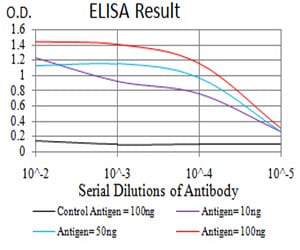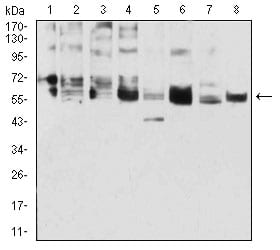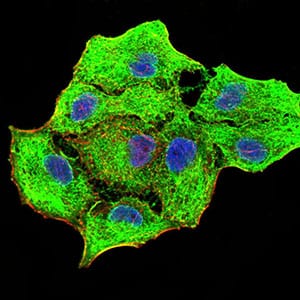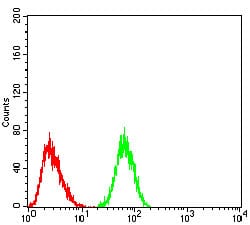




| WB | 咨询技术 | Human,Mouse,Monkey |
| IF | 咨询技术 | Human,Mouse,Monkey |
| IHC | 1/200 - 1/1000 | Human,Mouse,Monkey |
| ICC | 1/200 - 1/1000 | Human,Mouse,Monkey |
| FCM | 1/200 - 1/400 | Human,Mouse,Monkey |
| Elisa | 1/10000 | Human,Mouse,Monkey |
| Aliases | KRT5; K5; DDD; DDD1; EBS2; KRT5A |
| Entrez GeneID | 3852 |
| clone | 3D6D4 |
| WB Predicted band size | 62.4kDa |
| Host/Isotype | Mouse IgG1 |
| Antibody Type | Primary antibody |
| Storage | Store at 4°C short term. Aliquot and store at -20°C long term. Avoid freeze/thaw cycles. |
| Species Reactivity | Human,Mouse,Monkey |
| Immunogen | Purified recombinant fragment of human CK5 (AA: 258-357) expressed in E. Coli. |
| Formulation | Purified antibody in PBS with 0.05% sodium azide |
+ +
以下是关于CK5抗体的3篇参考文献及其摘要概述:
---
1. **文献名称**:*Immunohistochemical and clinical characterization of the basal-like subtype of invasive breast carcinoma*
**作者**:Nielsen TO, et al.
**摘要**:该研究通过免疫组化分析(包括CK5抗体)将乳腺癌分为基底样亚型,发现CK5阳性肿瘤与较差的预后相关,提示其在分子分型中的诊断价值。
2. **文献名称**:*CK5/6 in non-small cell lung cancer: A marker of squamous differentiation*
**作者**:Yanagi Y, et al.
**摘要**:文章验证了CK5/6抗体在非小细胞肺癌中的表达,发现其可作为鳞癌的可靠标志物,并提示CK5阳性患者可能对特定化疗方案更敏感。
3. **文献名称**:*Comparative analysis of CK5 antibodies in dermatopathology*
**作者**:Böer-Auer A, et al.
**摘要**:研究比较了不同克隆号(如XM26、D5/16 B4)的CK5抗体在皮肤鳞癌和表皮病变中的表现,指出D5抗体在基底细胞层染色中更具特异性。
---
如需扩展至第4篇,可补充:
4. **文献名称**:*CK5 expression in ductal carcinoma in situ: Association with recurrence risk*
**作者**:Livasy CA, et al.
**摘要**:探讨CK5在乳腺导管原位癌中的表达,发现CK5阳性病例更易复发,提示其可能作为侵袭性亚型的预测指标。
---
以上文献涵盖了CK5在乳腺癌、肺癌、皮肤病理中的诊断及预后应用,以及抗体性能比较,满足基础研究参考需求。
Cytokeratin 5 (CK5), a member of the intermediate filament protein family, is encoded by the *KRT5* gene and plays a structural role in maintaining epithelial cell integrity. It is predominantly expressed in basal and myoepithelial cells of stratified and glandular epithelia, such as the epidermis, mammary glands, prostate, and respiratory tract. CK5 forms heterodimers with CK14. providing mechanical resilience to tissues subjected to mechanical stress.
CK5 antibodies are widely used in immunohistochemistry (IHC) to identify cell lineage and differentiation status. In diagnostic pathology, CK5 expression helps distinguish epithelial subtypes, particularly in carcinomas. For example, CK5 positivity is a hallmark of basal-like breast cancers and squamous cell carcinomas, aiding their differentiation from adenocarcinomas (typically CK5-negative). It also serves as a marker for benign proliferations (e.g., basal cell hyperplasia) and certain neoplasms (e.g., mesotheliomas).
Research applications include studying epithelial-mesenchymal transition (EMT), tissue regeneration, and cancer stem cells, as CK5 is associated with progenitor cell populations. Aberrant CK5 expression is linked to genetic disorders like epidermolysis bullosa simplex, caused by *KRT5* mutations. As a prognostic marker, CK5 overexpression in tumors may indicate aggressive behavior. Its specificity and utility in dual-staining protocols (e.g., with p63) further enhance its diagnostic value in pathological subtyping.
×